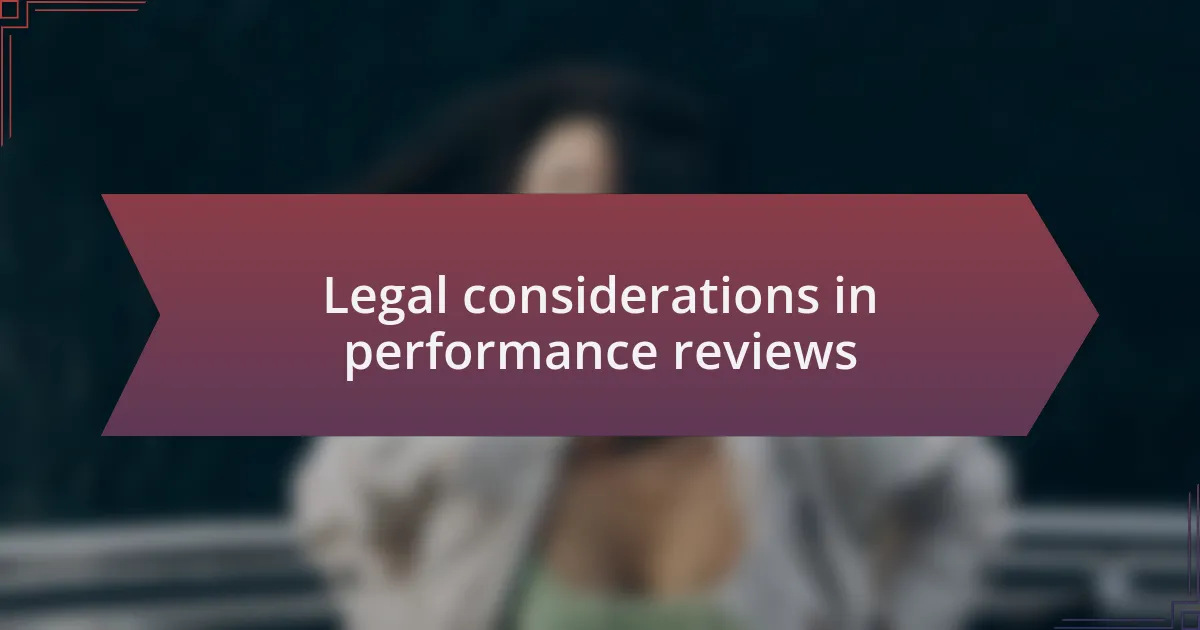Key takeaways:
- Performance reviews facilitate open dialogue between employees and managers, linking individual aspirations to organizational goals.
- Effective feedback, both timely and constructive, is essential for employee growth and motivation.
- Legal considerations in performance reviews include documenting assessments and avoiding personal biases to ensure fairness.
- Personalizing feedback strategies and incorporating ongoing discussions fosters a supportive environment, enhancing performance outcomes.

Understanding performance reviews
Performance reviews can feel daunting, can’t they? I remember the first time I faced one, my palms were sweaty, and my heart raced, wondering if my contributions would be acknowledged or overlooked. Understanding that these reviews are more than just a formality is crucial; they are an opportunity for meaningful feedback and growth.
When I think about the essence of performance reviews, I see them as a crucial link between employees’ aspirations and organizational goals. They serve as a platform for open dialogues, where employees can express their career ambitions while managers align those with the company’s objectives. Have you ever approached a performance review as a two-way street? It’s enlightening to realize that both parties have valuable insights to share.
Additionally, performance reviews are not just about past performance; they’re a springboard for future potential. I’ve experienced this firsthand when feedback transformed my approach to a project, leading to not just improved outcomes but also greater job satisfaction. It’s essential to view these reviews as a constructive process, focusing on development rather than merely evaluation.

Importance of effective feedback
Effective feedback is the backbone of a productive performance review process. I remember when a supervisor took the time to provide detailed feedback on my project. It wasn’t just about what I did right; it included areas for improvement, and that made all the difference. When employees receive constructive feedback, it empowers them to refine their skills and enhance their contributions.
Moreover, the impact of timely feedback can’t be overstated. I once found myself frustrated after completing a task but not receiving any response until months later. This delay not only diminished my motivation but also stunted my growth. Immediate feedback, on the other hand, fosters continuous improvement and keeps everyone aligned with the company’s vision.
When we think about the emotional aspect of feedback, it’s clear it can significantly influence an employee’s confidence and engagement. Have you ever received praise for a job well done? That recognition motivates me to aim even higher. Positive feedback reinforces desired behaviors, while well-delivered constructive criticism encourages personal and professional development, creating a healthier work environment.

Legal considerations in performance reviews
When conducting performance reviews, it’s crucial to be aware of potential legal pitfalls. I recall a situation where a colleague faced backlash after providing subjective performance scores without sufficient documentation. This underscores the importance of keeping detailed records that support every assessment. Not only does this practice protect the employer, but it also instills fairness in the process.
Additionally, consider the legal implications of feedback that may inadvertently cross into discriminatory territory. Reflecting on my experiences, I’ve seen managers unwittingly let personal biases seep into their reviews. For instance, a manager’s negative perception of an employee’s communication style led to unjust ratings. Organizations should implement training that emphasizes objectivity and encourages managers to focus on performance-related metrics, rather than personal attributes.
Lastly, it’s essential to understand the implications of employment contracts and company policies in the review process. I remember a discussion where a company failed to align their feedback practices with established policies, leading to confusion and grievances. Clear communication around performance criteria, documented in contracts, can mitigate risks and ensure everyone is on the same page. After all, clarity protects both parties and promotes a fair, transparent atmosphere for growth.

Techniques for effective performance discussions
Engaging in performance discussions requires a balance of honesty and empathy. I remember a time when I had to deliver disappointing news to a stellar employee. Rather than just focusing on what needed improvement, I made it a point to acknowledge their strengths upfront. By setting a positive tone, I found they were more open to feedback, which in turn encouraged a constructive dialogue about future goals.
Active listening is another crucial technique that often gets overlooked in these discussions. I often ask employees to share their thoughts on their own performance first. This approach not only empowers them but also provides me with valuable insights into their perspective. Have you ever noticed how when someone feels heard, it strengthens their engagement levels? It truly makes a difference.
Lastly, wrapping up the conversation with a clear action plan can make all the difference in ensuring that both parties leave feeling positive. I learned this the hard way after a discussion ended without a clear follow-up, leading to confusion. By summarizing key points and outlining specific goals, we’re not just closing the conversation; we’re paving the way for future success. What steps can you take to ensure your reviews are not just a formality but a meaningful stepping stone?

Crafting constructive performance feedback
When crafting constructive performance feedback, clarity is essential. I recall a time when I had to guide a team member who was struggling with meeting deadlines. Instead of vague remarks, I provided specific examples of missed timelines and the impact on the team. This clarity not only made the issue tangible for them but also opened up a productive discussion about strategies to enhance time management.
It’s also important to frame feedback in a way that encourages growth rather than defensiveness. I’ve found that using “I” statements, like “I noticed…” can help soften the blow and reduce resistance. Ask yourself, have you ever felt cornered by criticism? By addressing issues collaboratively, I’ve seen employees transition from feeling attacked to actively seeking solutions. It’s transformative when feedback turns into a shared journey.
Finally, nurturing a culture of ongoing feedback can fundamentally change how performance reviews are received. In my experience, when I make it a point to provide regular check-ins rather than waiting for annual reviews, I create a more open atmosphere. How can you incorporate informal feedback opportunities into your routine? Embracing continuous dialogue means that when performance reviews happen, they are no longer a shock but a summary of ongoing conversations.

Personalizing performance review strategies
Tailoring performance review strategies to individual employees can significantly enhance their effectiveness. I remember when I personalized a review for a team member who thrived on positive reinforcement. Instead of leading with areas for improvement, I began our discussion by highlighting her strengths and achievements. This approach not only set a positive tone but also motivated her to embrace constructive feedback with an open mind.
It’s crucial to recognize that each person learns and responds differently. I’ve had colleagues who appreciated data-driven insights while others preferred more narrative feedback. By asking questions like, “How do you feel about your progress this quarter?” I encourage employees to share their perceptions, which allows me to adjust my feedback to their unique needs. This kind of engagement fosters a more supportive atmosphere and can produce remarkable changes in performance.
Moreover, integrating personal goals into the performance review process can solidify connections between individual aspirations and organizational objectives. For instance, I once worked with an employee passionate about leadership development. By aligning her career goals with our team’s vision, we crafted a tailored plan that not only boosted her engagement but also propelled her towards her ambitions. How can you better connect your staff’s personal achievements with company success? In my experience, this synergy leads to a more motivated and productive work environment.